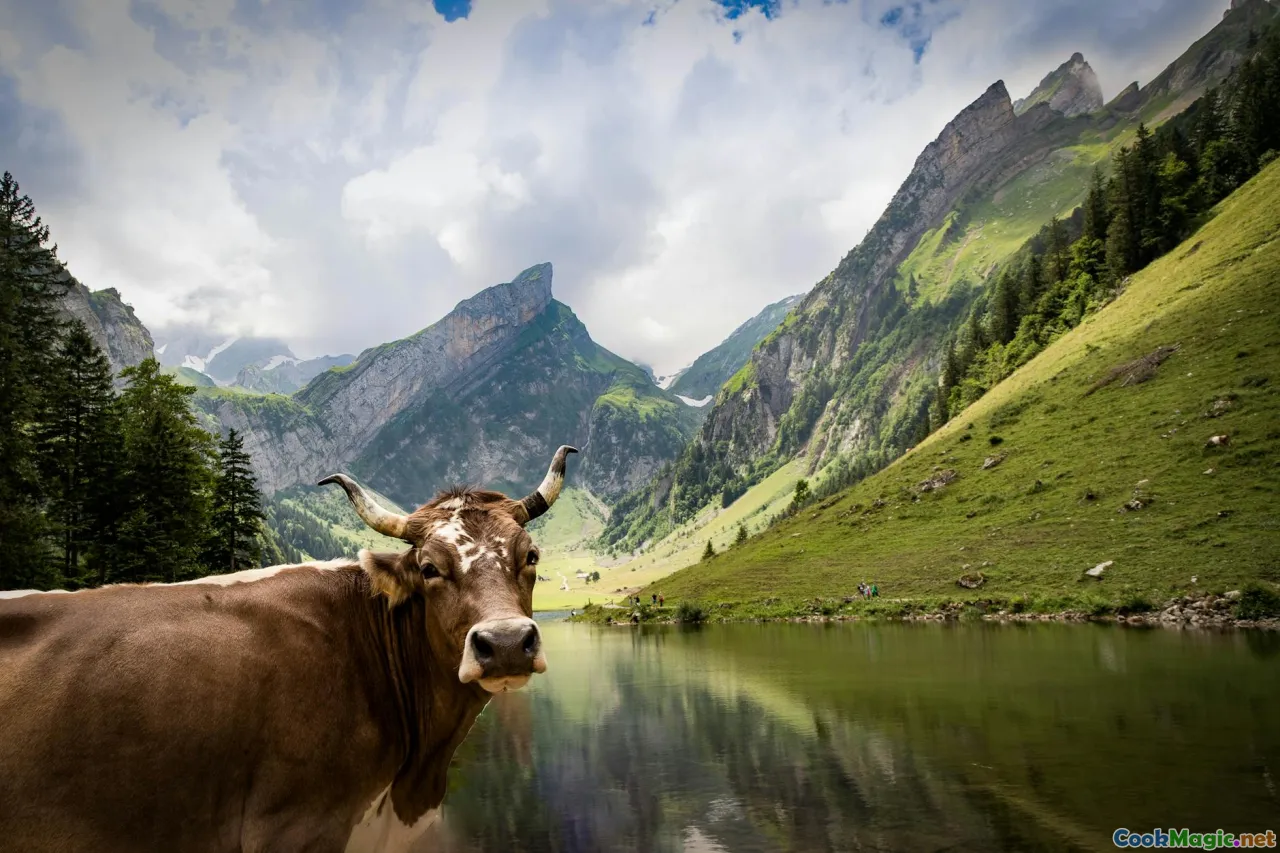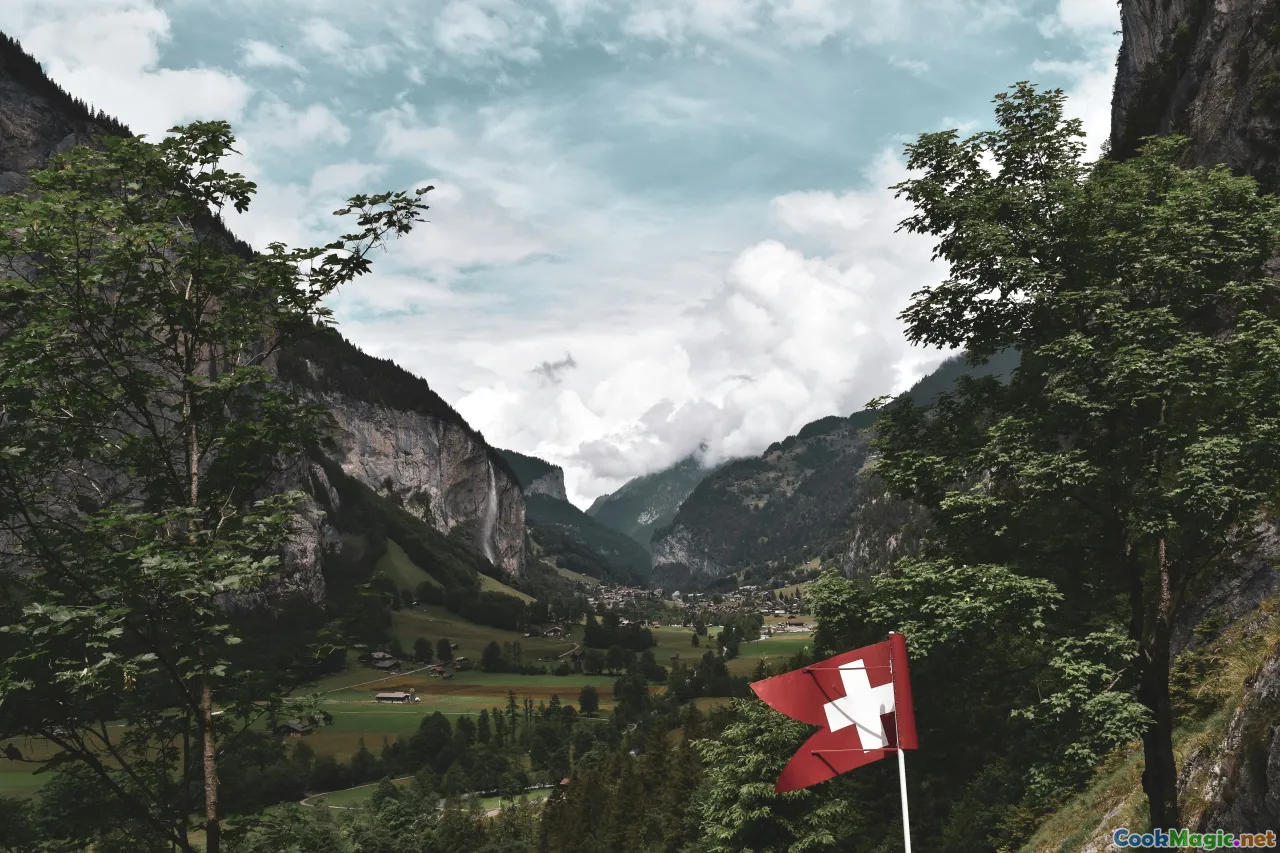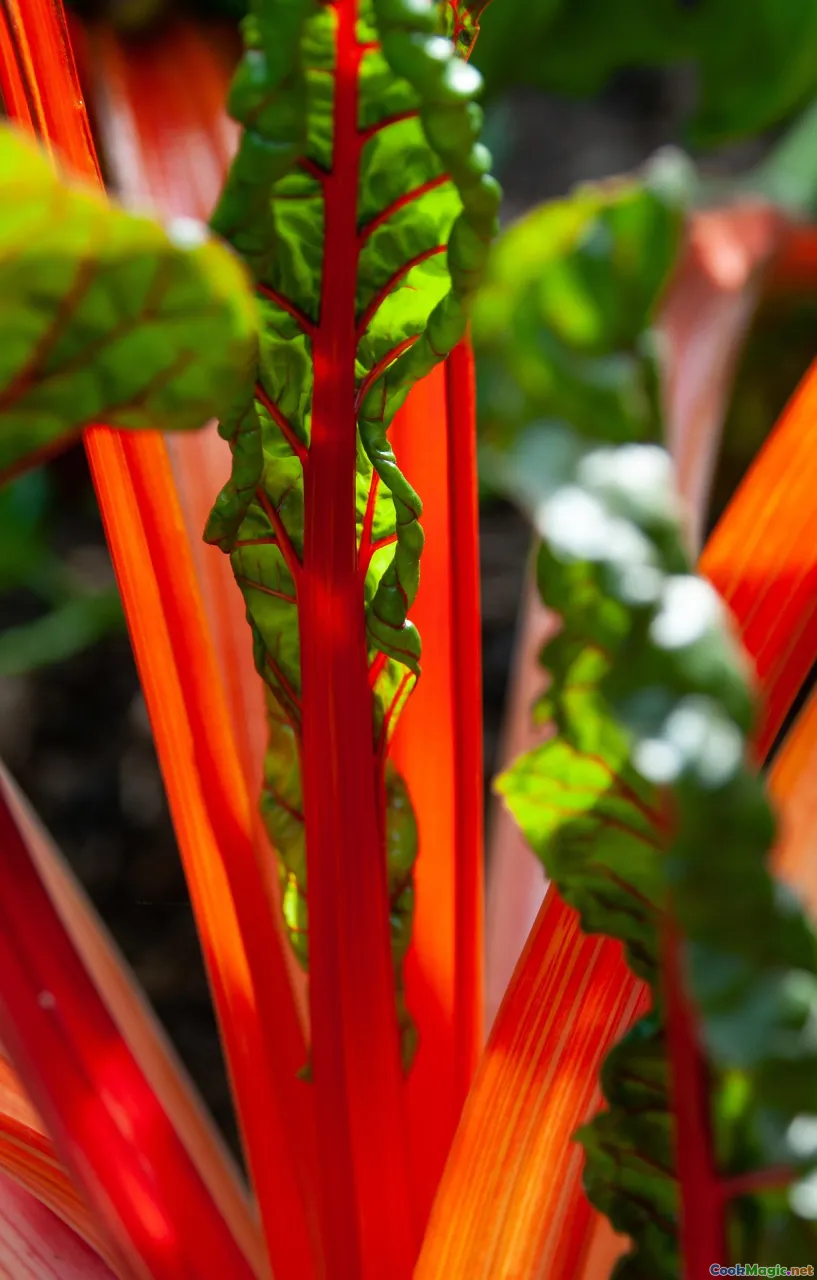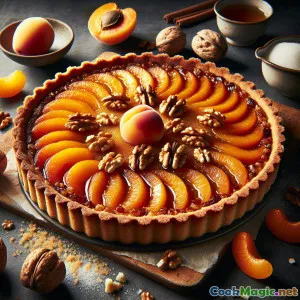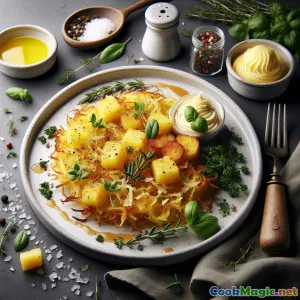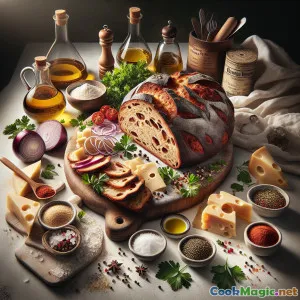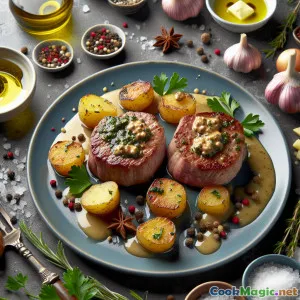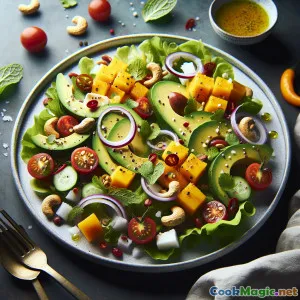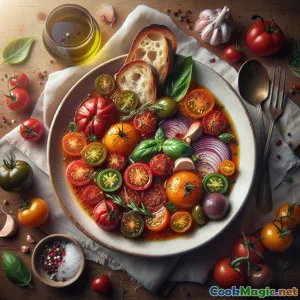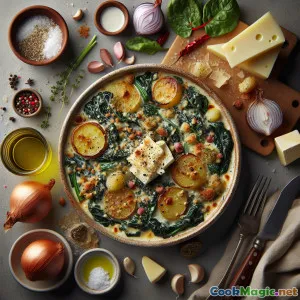
ऐपेनज़ेलर चार्ड ग्रैटिन के साथ क्रिस्प रोस्टी क्रस्ट
(Appenzeller Chard Gratin with Crisp Rösti Crust)
(0 समीक्षाएँ)सामग्री
-
700 grams स्विस चार्ड
(Stems and leaves separated, chopped, well washed)
-
200 grams Appenzeller चीज
(Medium-spicy variety, coarsely grated)
-
300 grams मोटी आलू
(Coarsely grated and squeezed very dry for rösti crust)
-
45 grams नमक रहित मक्खन
(Divided, plus extra for greasing dish)
-
15 ml जैतून का तेल
(For browning rösti crust)
-
80 grams प्याज
(पतला कटा हुआ)
-
2 cloves लहसुन
(कटा हुआ)
-
200 ml हेवी क्रीम
(35% fat, warmed)
-
120 ml पूर्ण दूध
(For a lighter sauce; replace with more cream for richer)
-
60 ml सूखा सफेद शराब
(For deglazing; can omit for alcohol-free)
-
5 grams डिज़ॉन सरसों
(Whisked into the cream for depth)
-
1 grams पीसी हुई जायफल
(Freshly grated for best aroma)
-
2 grams काली मिर्च
(ताज़ा पिसा हुआ)
-
6 grams कोषेर नमक
(स्वाद के अनुसार समायोजित करें)
-
2 grams ताजा थाइम पत्तियां
(कटा हुआ)
-
1 tsp नींबू का छिलका
(Adds brightness to the greens)
-
25 grams राई ब्रेड क्रम्ब्स
(अतिरिक्त कुरकुरेपन के लिए वैकल्पिक टॉपिंग)
-
25 grams भुनी हुई हेज़लनट्स
(मोटे टुकड़ों में कटा हुआ, सजावट के लिए)
(Stems and leaves separated, chopped, well washed)
(Medium-spicy variety, coarsely grated)
(Coarsely grated and squeezed very dry for rösti crust)
(Divided, plus extra for greasing dish)
(For browning rösti crust)
(पतला कटा हुआ)
(कटा हुआ)
(35% fat, warmed)
(For a lighter sauce; replace with more cream for richer)
(For deglazing; can omit for alcohol-free)
(Whisked into the cream for depth)
(Freshly grated for best aroma)
(ताज़ा पिसा हुआ)
(स्वाद के अनुसार समायोजित करें)
(कटा हुआ)
(Adds brightness to the greens)
(अतिरिक्त कुरकुरेपन के लिए वैकल्पिक टॉपिंग)
(मोटे टुकड़ों में कटा हुआ, सजावट के लिए)
पोषण
- परोसने की संख्या: 4
- सेवा आकार: 1 square (250g)
- Calories: 520 kcal
- Carbohydrates: 24 g
- Protein: 20 g
- Fat: 36 g
- Fiber: 5 g
- Sugar: 6 g
- Sodium: 780 mg
- Cholesterol: 95 mg
- Calcium: 560 mg
- Iron: 3.1 mg
निर्देश
-
1 - Heat oven and prepare dish:
Preheat oven to 200°C (392°F). Generously butter a 22×30 cm baking dish or similar 2-quart casserole.
-
2 - Prep and drain the chard:
Separate chard stems from leaves. Chop stems into 1 cm pieces and leaves into ribbons. Rinse thoroughly and spin or pat dry.
-
3 - Blanch and squeeze greens:
Bring a pot of salted water to a boil. Blanch stems for 2 minutes, add leaves for 1 minute more. Drain, then squeeze out excess water; set aside.
-
4 - Grate cheese and potatoes:
Coarsely grate Appenzeller. Coarsely grate potatoes, then wring them dry in a clean towel until no liquid drips.
-
5 - Sauté aromatics and chard:
Melt 20 g butter in a large skillet over medium heat with olive oil. Add onion and cook until translucent, 3–4 minutes. Stir in garlic, then chard stems and leaves. Season with 3 g salt, pepper, nutmeg, thyme, and lemon zest. Deglaze with wine if using; cook until nearly dry.
-
6 - Form and set the rösti crust:
Toss dried potatoes with a pinch of salt and pepper. Melt 15 g butter and mix in. Press potatoes evenly into the buttered dish to form a compact base. Bake 10–12 minutes to set and lightly crisp.
-
7 - Warm the cream mixture:
In a small saucepan, warm cream and milk with Dijon, remaining salt, a pinch more pepper, and a whisper of nutmeg. Do not boil; just heat until steamy.
-
8 - Assemble the gratin:
Scatter one-third of the grated Appenzeller over the rösti crust. Spoon chard mixture on top. Pour the warm cream evenly over. Top with remaining cheese; sprinkle rye breadcrumbs if using.
-
9 - Bake until bubbling and golden:
Bake 22–25 minutes until the edges bubble and the top is deeply golden. If needed, broil 1–2 minutes for extra color.
-
10 - Rest and Garnish:
Let stand 10 minutes for the sauce to thicken. Sprinkle with toasted hazelnuts, slice into squares, and serve hot.
Preheat oven to 200°C (392°F). Generously butter a 22×30 cm baking dish or similar 2-quart casserole.
Separate chard stems from leaves. Chop stems into 1 cm pieces and leaves into ribbons. Rinse thoroughly and spin or pat dry.
Bring a pot of salted water to a boil. Blanch stems for 2 minutes, add leaves for 1 minute more. Drain, then squeeze out excess water; set aside.
Coarsely grate Appenzeller. Coarsely grate potatoes, then wring them dry in a clean towel until no liquid drips.
Melt 20 g butter in a large skillet over medium heat with olive oil. Add onion and cook until translucent, 3–4 minutes. Stir in garlic, then chard stems and leaves. Season with 3 g salt, pepper, nutmeg, thyme, and lemon zest. Deglaze with wine if using; cook until nearly dry.
Toss dried potatoes with a pinch of salt and pepper. Melt 15 g butter and mix in. Press potatoes evenly into the buttered dish to form a compact base. Bake 10–12 minutes to set and lightly crisp.
In a small saucepan, warm cream and milk with Dijon, remaining salt, a pinch more pepper, and a whisper of nutmeg. Do not boil; just heat until steamy.
Scatter one-third of the grated Appenzeller over the rösti crust. Spoon chard mixture on top. Pour the warm cream evenly over. Top with remaining cheese; sprinkle rye breadcrumbs if using.
Bake 22–25 minutes until the edges bubble and the top is deeply golden. If needed, broil 1–2 minutes for extra color.
Let stand 10 minutes for the sauce to thicken. Sprinkle with toasted hazelnuts, slice into squares, and serve hot.
ऐपेनज़ेलर चार्ड ग्रैटिन के साथ क्रिस्प रोस्टी क्रस्ट :के बारे में ज़्यादा जानकारी
Why this gratin stands out
This Appenzeller Chard Gratin is a love letter to Swiss mountain cooking: rustic ingredients treated with precision and respect. Silky, emerald chard is tucked into a creamy mustard-and-nutmeg sauce, showered with nutty, aromatic Appenzeller cheese, and anchored by an ingenious rösti-style potato crust. The result is a casserole that slices neatly, hits contrasting textures—crisp base, velvety greens, gooey top—and radiates the warming comfort of Alpine kitchens.
Ingredient spotlight
- Appenzeller cheese: Famous for its herbal brine, Appenzeller brings a distinctive, savory tang and superb melt. Choose “mittel-würzig” (medium-spicy) for balance; “extra” is punchier and delightful for cheese lovers.
- Swiss chard: A quintessential cool-climate green, with sturdy stems and tender leaves. Blanching tames bitterness and preserves color; a quick sauté concentrates flavor.
- Rösti crust: Using grated, well-dried waxy potatoes for the base gives the gratin structure and crunch, evoking Switzerland’s beloved potato pancake.
- Cream and mustard: Gentle heat melds dairy sweetness with Dijon’s subtle bite; nutmeg amplifies the dairy and greens without overwhelming them.
Technique keys for success
- Manage moisture. Chard holds water. Blanch briefly, squeeze thoroughly, then sauté until nearly dry. Likewise, wring the grated potatoes until no liquid drips; this is critical for a crisp crust.
- Layer thoughtfully. A thin scattering of cheese directly on the rösti acts as a moisture barrier, keeping the base crisp while the chard and cream stay succulent above.
- Warm, don’t boil, the cream. Heating the dairy with mustard and spices helps it coat the leaves evenly and prevents a broken or grainy sauce.
- Rest before slicing. Ten minutes out of the oven allows starches and proteins to set, ensuring clean squares and concentrated flavor.
Variations and substitutions
- Cheese blend: Mix Appenzeller with Gruyère or Sbrinz for nuanced melt and sharper edges. Replace up to one-third without losing the signature taste.
- Greens: Swap in spinach or kale (quick-blanch kale 3–4 minutes). If using spinach, skip the initial blanch and sauté directly after squeezing.
- Gluten-free: Omit rye breadcrumbs. The gratin remains satisfyingly crunchy thanks to the rösti base.
- Alcohol-free: Replace wine with a splash of vegetable stock plus 1 tsp lemon juice for brightness.
- Herb accents: Thyme is classic, but marjoram or chives are lovely, too.
Make-ahead and storage
- Partial prep: Blanch/sauté the chard and grate the cheese a day ahead. Keep components chilled separately.
- Assemble-then-bake: Form the rösti crust and par-bake, cool, then build the gratin and refrigerate for up to 12 hours. Bake from chilled, adding 5–8 minutes.
- Leftovers: Refrigerate up to 3 days. Reheat, covered, at 180°C until hot, then uncover to re-crisp for a few minutes. Freeze tightly wrapped portions for up to 2 months; reheat from frozen at 180°C.
Serving ideas
- Pairing: A dry Swiss Fendant or a crisp Riesling cuts through richness. For non-alcoholic, try unsweetened apple must or a tart cider alternative.
- Plate with: A simple dill-cucumber salad, pickled beets, or a snappy apple-and-endive slaw to contrast the gratin’s creaminess.
History and cultural notes
Gratin as a technique is rooted in French kitchens, yet the Alpine world embraced it early, leveraging hearth ovens, sturdy root vegetables, and hard mountain cheeses. Appenzeller, crafted in the Appenzell region since at least the 13th century, is washed with a fragrant brine of herbs and white wine or cider, developing its signature complexity. Swiss chard, despite its name, traces to the Mediterranean but thrives in Switzerland’s cooler summers. Rösti, once a farmers’ breakfast in the German-speaking cantons, is now a national icon. This recipe harmonizes those threads: a classic gratin, an unmistakably Swiss cheese, resilient greens, and the beloved potato pancake reborn as a sturdy crust.
Tips, tricks, and troubleshooting
- If the top browns before the center bubbles, tent loosely with foil for part of the bake, then uncover to finish.
- Too watery? You likely didn’t squeeze the chard or potatoes enough. Next time, press harder and extend the sauté until steam wanes.
- Not crisp enough base? Pre-bake the rösti crust a few extra minutes, and avoid overloading with cream; the amounts here are calibrated for balance.
- Flavor booster: Rub the dish with a cut clove of garlic before buttering for subtle perfume.
- Texture flourish: A handful of toasted hazelnuts lends Alpine character and a pleasing crunch; they also echo Appenzeller’s nutty notes.
Personal note
I love this gratin for the way it honors place. You can smell the herbal warmth of Appenzell in the bubbling cheese, see the highland gardens in the chard’s deep green, and feel the practicality of farm kitchens in the rösti base. It’s elegant enough for guests, but sturdy and simple enough for a weeknight with a salad. Make it once, and it becomes a cold-weather ritual—one pan, big reward, and the kind of aroma that has everyone drifting toward the kitchen, asking when it’s ready.

